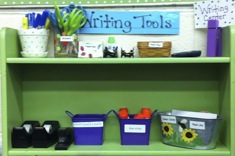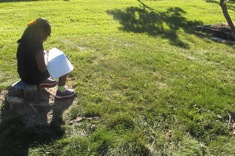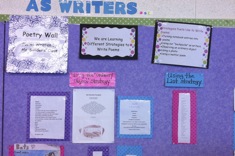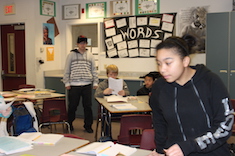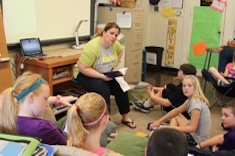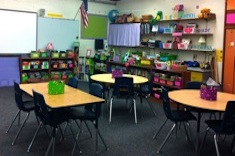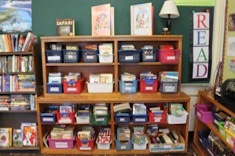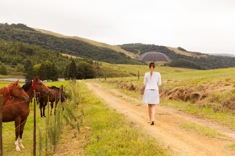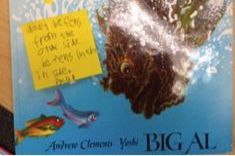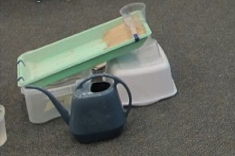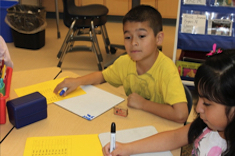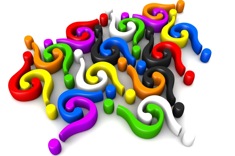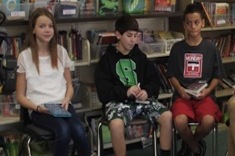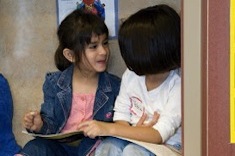Articles
Here is where you’ll find all the latest print features from our contributors. If you’d like to browse specifically by grade level, topic, or contributor, you can use the links in the right sidebar.
Latest Content
Classroom Environment: Access to Supplies
Melanie Swider believes access to supplies is crucial for student independence, and she even has students in charge of monitoring and replenishing materials. This is the final installment in Melanie's classroom environment series.
I Don’t Want to Know What You Did Last Summer: Rethinking Narrative Nonfiction
Stella Villalba rethinks the seemingly innocuous “What did you do last summer?” writing assignment at the start of the year, especially for children who may have more limited experiences than peers.
Classroom Environment: Bulletin Boards
Melanie Swider shares her favorite bulletin boards, another installment in her classroom design series.
Doodlebug
What makes a teacher memorable? Recognizing a child's passions from the very first day of school. Jennifer Schwanke recounts how her second-grade teacher did just that.
Beyond Cute: Print Rich with Purpose
Shari Frost cautions against overly stylized text in wall displays.
Back to Basics: Routines in Writing Workshops
Ruth Ayres considers what's essential in writing workshop routines.
Perfect Frosting and Workshop Routines
Things start to fall apart in a classroom when a beloved teacher is replaced with a long-term substitute. Deb Gaby shares how an analogy helps the class get back on track.
Read Alouds as “Third Things”
Katherine Sokolowski uses read alouds early in the year to help students reflect on how to be kind and thoughtful members of a classroom community.
Bring Back Read Aloud
Jennifer Schwanke interviews older students and discovers their most beloved memories of elementary school involve read alouds.
Strategies for Using Reader’s Notebooks
Melanie Swider enhances read alouds and the entire reading workshop with creative uses for reading notebooks.
Creating a Classroom Environment That Supports Community Building and Independence
Melanie Swider shares how classroom design is linked to community building.
More Than Dr. Seuss Hats: Why Events Matter
Franki Sibberson explains how scheduling big events can do important work in building the reading community.
The Beginnings of a Middle School Literacy Community
What do you do on day one? Christy Rush-Levine describes the routines in her middle school classroom.
Potato the Crow: Blurring the Lines Between Reality, Fantasy, and Play with Young Learners
Leslie Woodhouse discovers a dollar store find takes on a life of its own in her preschool classroom in this delightful essay.
Curating a Classroom Library
Katherine Sokolowski explains why it is important to sort and weed out books carefully before the new year begins.
Classroom Environment: Classroom Libraries
Melanie Swider looks at classroom library design as part of her classroom environment series.
Shaking Off the Village
Shirl McPhillips writes of the glories of summer walks for teachers in her latest poem and reflection.
Anchoring Language
Katie DiCesare thinks about what language supports student independence early in the year and how to share this in an anchor chart with her first graders.
The Weird Wonders of Genius Hour
Mary Lee Hahn explains how Genius Hour fosters the language of risk, exploration, and uncertainty with her fifth graders all year long.
Time for English Language Learners
Stella Villalba finds what English language learners need more than almost anything else is patience with silence and time to formulate responses.
Questioning Questions: Rethinking Prompts for Reading Conferences
Jan Burkins and Kim Yaris are rethinking questions used in one-on-one reading conferences.
Provoking Young Readers
Melanie Meehan finds read aloud is a great time for children to connect opinions and experiences.
Book Clubs Then and Now: Change Is the Constant
Mary Lee Hahn considers how book clubs have changed over time in her fifth-grade classroom.
Feed Forward
Carly Ullmer learns a powerful lesson about teaching her middle school students to respond to peer writing.
Sorting with “Kinds of”: Technique Minilessons
Ruth Ayres finds it is helpful for teachers and students to sort through different types of writing techniques lessons in planning for instruction and revision.
Digital Literacy Workshop
Maria Caplin has suggestions for making transitions to digital literacy in reading and writing workshops.
Worth the Investment
Melanie Quinn finds it is worth taking time for community building in schools and classrooms, because the practice pays dividends all year long.
Words with Friends
Melissa Kolb explores what needs to be in place for our youngest students to learn how to converse kindly.
Setting Goals During Mini-Celebrations
Melanie Meehan recommends linking goal setting to small celebrations as a great way to build community and skills at the same time.
Connecting Literacy and Math (PODCAST)
This podcast with Kassia Omohundro Wedekind explores connections between literacy and math instruction, particularly in the areas of strategies, problem-solving, and narrative abilities.
Browse Content By
Type
Category
- Assessment Tools
- Big Fresh Archives
- Booklists
- Choice Numeracy
- Classroom Design
- Common Core
- Community Building
- Conferring
- Content Literacy
- Digital Literacy
- English Language Learners
- Equity
- Family Relations
- Free Samples
- Guiding Groups
- Leadership
- Literacy Coaches
- Mentor Texts
- Minilessons
- New Teacher Mentors
- Podcasts
- Poetry
- Quote Collections
- Reading Strategies
- Self Care
- Struggling and Striving Learners
- Talking and Listening
- Teacher Study Groups
- Teaching Reading
- Teaching Writing
- Word Study and Vocabulary
Author
- Melissa Quimby
- Nawal Qarooni
- Gwen Blumberg
- Julie Cox
- The Lead Learners
- Hannah Tills
- Josie Stewart
- Ruth Metcalfe
- Mallory Messenger
- Becca Burk
- Jodie Bailey
- Vivian Chen
- Mary Brower
- Tiffany Abbott Fuller
- Stephanie Affinito
- Ruth Ayres
- Leigh Anne Eck
- Heather Fisher
- Shari Frost
- Julie Johnson
- Suzy Kaback
- Gigi McAllister
- Shirl McPhillips
- Melanie Meehan
- Cathy Mere
- Debbie Miller
- Tara Barnett and Kate Mills
- Tammy Mulligan
- Dana Murphy
- Bitsy Parks
- David Pittman
- Brenda Power
- Heather Rader
- Matt Renwick
- Mandy Robek
- Christy Rush-Levine
- Gretchen Schroeder
- Jen Schwanke
- Brian Sepe
- Katherine Sokolowski
- Stella Villalba
- Jennifer Vincent
Grade Level
Choice Literacy Membership
Articles
Get full access to all Choice Literacy article content
Videos
Get full access to all Choice Literacy video content
Courses
Access Choice Literacy course curriculum and training

